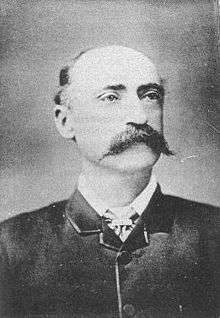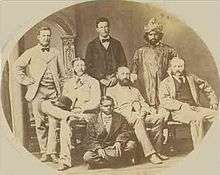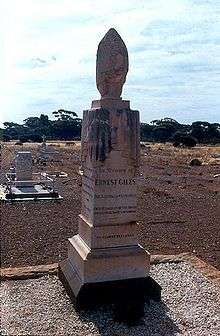Ernest Giles

William Ernest Powell Giles (20 July 1835 – 13 November 1897),[2] best known as Ernest Giles, was an Australian explorer who led five major expeditions in central Australia.[3][4]
Early life
Ernest Giles was born in Bristol, England, son of William Giles, a merchant, and Jane Elizabeth, née Powell. Giles was educated at Christ's Hospital school, Newgate, London.[5] In 1850, at the age of 15, he emigrated to Australia, joining his parents, and took up residence in Adelaide, South Australia. In 1852 Giles went to the Victorian goldfields, then became a clerk at the Post Office in Melbourne, and later at the County Court. Soon tiring of town life Giles went to the back country and obtained valuable experience as a bushman. In 1865, he explored north-west of the Darling River in the Yancannia Range looking for pastoral country and land capable of cultivating hemp, as it was valuable for rope at the time.
Exploration

Giles did not attempt an organised expedition until 1872, when with two other men he left Chambers Pillar, South Australia (now in the Northern Territory), on 22 August and traversed much previously untrodden country to the north-west and west. Finding their way barred by Lake Amadeus and that their horses were getting very weak, a return was made to the Finke River and then to Charlotte Waters and Adelaide, where Giles arrived in January 1873. Giles looked upon his expedition as a failure, but he had done well considering the size and equipment of his party.
Second expedition
Giles' friend Baron von Mueller raised a subscription so that a new expedition could be made. The services of William Tietkens as first assistant were obtained, and with two other men a start was made on 4 August 1873. The journey began considerably south from the previous expedition and from the Alberga River a generally western course was traversed. A month later in the Musgrave Ranges a fine running river was found and named the Ferdinand and by 3 October 1873 the party was approaching longitude 128 East. The country was extremely dry and though tested in various directions it was a constant struggle to get enough water to keep the horses going. Early in November, having passed longitude 126, a partial return was made and on 20 December 1873 the neighbourhood of Mount Scott was reached. A turn to the north and then west was made and the farthest westerly point was reached on 23 April 1874. Giles and one of the men, Alfred Gibson, had been scouting ahead when the latter's horse died. Giles gave him his own horse with instructions to follow their tracks back and obtain assistance. Giles made his way back to their depot on foot in eight days, almost completely exhausted, to find that Gibson had not reached the camp. A search was made for him for several days without success. The stores were almost finished, nothing further could be done, and on 21 May 1874 the return journey began. Giles named the desert Gibson Desert after his companion. On 24 June 1874 they were on a good track to the Finke River and on 13 July 1874 Charlotte Waters was reached. Giles had again failed to cross the continent, but in the circumstances all had been done that was possible.
Giles was the first European to see the rock formations of The Olgas, now known by their Aboriginal name of Kata Tjuta, and Lake Amadeus. He had wanted to name these Mt Mueller and Lake Ferdinand respectively, to honour his benefactor Baron Ferdinand von Mueller, however Mueller prevailed on him to instead honour the King Amadeus of Spain and Queen Olga of Württemberg. Giles supposedly discovered Uluru (formerly Ayers Rock), but was beaten to the claim by a competing explorer, William Gosse.
Third, fourth and fifth expeditions

Early in 1875 Giles prepared his diaries for publication under the title Geographic Travels in Central Australia, and on 13 March 1875, with the generous help of Sir Thomas Elder, he began his third expedition. Proceeding considerably to the north from Fowler's Bay the country was found to be very dry. Retracing his steps Giles turned east, and eventually going round the north side of Lake Torrens reached Elder's station at Beltana. There the preparations for his fourth journey were made, and with Tietkens again his lieutenant, and with what Giles had always wanted, a caravan of camels, a start was made on 6 May. Port Augusta was reached on 23 May and, after taking a northerly course to clear the lakes, a generally westerly course was followed. Some water was carried, and the party was saved the continual excursions in search of water for horses that had caused so much difficulty during previous expeditions. Towards the end of September over 323 miles (520 km) had been covered in 17 days without finding water, when on 25 September the native Tommy found an abundant supply in a small hollow between sand dunes at Queen Victoria Spring, and the party was saved.[1][6] After a rest of nine days the journey was resumed on 6 October the course being still west. Ten days later the expedition was attacked by a large body of aborigines and Giles was compelled to fire on them. On 4 November they met a white stockman at Tootra out-camp, east of Bindi Bindi. Their course was west to Walebing Station, then south-west and on 11 November they arrived at New Norcia where they were welcomed by Bishop Salvado.[7] On 17 November 1875 the party arrived at Guildford and Perth the next day, where they received an enthusiastic reception.
Giles stayed for two months at Perth. Tietkens and Jess Young, another member of the expedition, went back to Adelaide by sea, and on 13 January 1876 Giles began the return journey taking a course generally about 400 miles north of the last journey. He arrived at Adelaide in September 1876 after a good journey during which the camels were found to be invaluable.
Late life and legacy

Giles worked as a land classifier in the Western District of Victoria from 1877–79.
In 1880 he published The Journal of a Forgotten Expedition, it being an account of his second and third expeditions, then in 1889 appeared Australia Twice Traversed: The Romance of Exploration[1] in two substantial volumes. This gives an account of his five expeditions. He made a number of other minor journeys and his last years were spent as a clerk in the Inspector of Mines' office at Coolgardie, where his great knowledge of the interior was always available for prospectors. Giles was made a fellow and awarded the Patron's Gold Medal of the Royal Geographical Society in 1880 and was made Cavaliere dell'Ordine della Corona d'Italia (Knight of the Order of the Crown of Italy) by King Vittorio Emanuele II.[1]
Despite his explorations, the various Australian governments at the time turned their respective backs on his achievements once they had been completed, and refused to patronise any further exploits or give him much in the way of financial reward. Governor Sir William Jervois claimed on 11 October 1881, "I am informed that he gambles and that his habits are not always strictly sober".
After a short illness Giles died of pneumonia at his nephew's house in Coolgardie on 13 November 1897 and was buried at the Coolgardie Cemetery. He was unmarried. It was reported at the time:
He has left behind a name that will be long remembered and held in honor as one who had devoted the best years of his life to one of the noblest causes that man can engage".[8]
H. H. Finlayson in The Red Centre: man and beast in the heart of Australia (1935) said of Giles:
All who have worked in that country since Giles's time have felt both admiration and astonishment at the splendid horsecraft, the endurance, and the unwavering determination with which these explorations were carried through ... To read Giles's simple account of those terrible rides into the unknown on dying horses with an unrelieved diet of dried horse for weeks at a time, with the waters behind dried out and those ahead still to find, is to marvel at the character and strength of the motive which could hold a man constant in such a course.
In 1976 he was honoured on a postage stamp bearing his portrait issued by Australia Post.[9]
Mount Giles, the third highest mountain in the Northern Territory; Lake Giles, 160 km (100 mi) north of Southern Cross, Western Australia; and the Giles Weather Station, near the Western Australian-South Australian border, were named after him.
Ernest Giles was no relation to the explorer Alfred Giles, though they knew each other professionally.[10]
See also
References
- 1 2 3 4 Giles, Ernest (1889). Australia twice traversed: the romance of exploration, being a narrative compiled from the journals of five exploring expeditions into and through central South Australia and Western Australia from 1872 to 1876. 2. Sampson Low, Marston, Searle & Rivington. ISBN 0-86824-015-X.
- ↑ "THE CYCLIST SOLDIER.". The Sydney Morning Herald. National Library of Australia. 26 January 1901. p. 8. Retrieved 1 May 2012.
- ↑ Serle, Percival (1949). "Giles, Ernest". Dictionary of Australian Biography. Sydney: Angus and Robertson. Retrieved 22 November 2008.
- ↑ Louis Green, 'Giles, Ernest (1835–1897)', Australian Dictionary of Biography, Volume 4, Melbourne University Press, 1972, pp 246–247. Retrieved 22 November 2008
- ↑ "Cut among the People.". The Register News-Pictorial. National Library of Australia. 11 July 1930. p. 6. Retrieved 1 May 2012.
- ↑ Rusden, George William (1883). History of Australia. Chapman and Hall. p. 224. ISBN 9781108030571. Retrieved 3 February 2015.
- ↑ "Victoria Plains, November 12.". The Inquirer & Commercial News. 17 November 1875. p. 3. Retrieved 26 October 2011.
- ↑ "Ernest Giles". Australian Town and Country Journal. 20 November 1897. p. 8. Retrieved 26 October 2011.
- ↑ "Image of Giles stamp". Australian Stamp and Coin Company. Retrieved 30 August 2009.
- ↑ "Alfred Giles – Enjoying Life at 80.". The Mail. National Library of Australia. 22 September 1928. p. 3. Retrieved 30 January 2013.
External links
- Australia Twice Traversed: The Romance of Exploration at eBooks @ Adelaide
- Works by Ernest Giles at Project Gutenberg
- Works by or about Ernest Giles at Internet Archive
- William Ernest Powell Giles at Flinders Ranges Research
